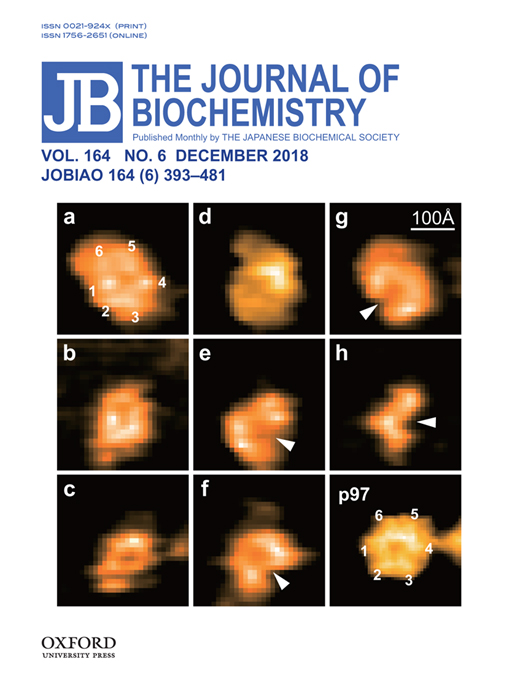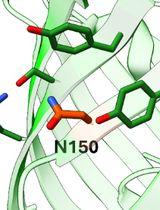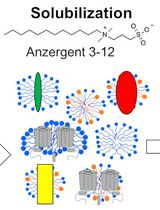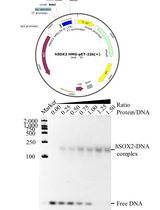- EN - English
- CN - 中文
Preparation and Purification of Active Recombinant Human Pancreatic Lipase in Escherichia coli
重组人胰脂肪酶在大肠杆菌中的表达和纯化
发布: 2019年07月05日第9卷第13期 DOI: 10.21769/BioProtoc.3286 浏览次数: 5865
评审: Alessandro DidonnaLouise Jane WalportJane Antony
Abstract
Human pancreatic lipase (HPL) is the main lipolytic enzyme involved in the digestion of dietary fat. An active recombinant human pancreatic lipase (recHPL) was successfully prepared for the first time in an Escherichia coli (E. coli) expression system using a short Strep-tag II (ST II). The recHPL-ST II was solubilized with 8 M urea from the E. coli lysate and purified on a Strep-Tactin-Sepharose column. After refolding by stepwise dialyses against decreasing concentrations of urea in the presence of glycerol and Ca2+ for two days followed by gel filtration FPLC, 1.8-6 mg of active recHPL-ST II was obtained from 1 L of culture. Here we report the expression, purification, and optimized refolding procedures for active recHPL from E. coli, thus establishing it as a suitable system for the production of recHPL of high purity and scaling up.
Keywords: Human pancreatic lipase (人胰腺脂肪酶)Background
Mammalian lipase, essential for the dietary fat digestion and absorption, can be used for development of an anti-obesity treatment. However, obtaining pure and stable native mammalian lipase has been a challenge because it is often degraded by co-existing proteases in the pancreatic juice. Due to the limited availability of human tissue samples and their potential risk for disease transmission, it may be best to prepare HPL using recombinant expression systems. Several methods have been reported to express recHPL using yeast (Yang and Lowe, 1998), insect (Thirstrup et al., 1993), or mammalian cells (Canalias et al., 1994), which require culturing for at least 5, 6, or 10 days, respectively. The recHPLs obtained using these cells require strict quality control to achieve homogeneity because they are differentially glycosylated. The use of E. coli as an expression system can avoid these problems in addition to providing other benefits such as ease of culture and purification. Therefore, we have established a protocol for optimized expression, purification, and refolding of active recHPL from E. coli. This method requires only two days of culturing, is easy to scale up at low cost, and is convenient because it circumvents the need to control the glycosylation pattern of the recombinant protein. Although the recHPL is non-glycosylated and native porcine pancreatic lipase (PPL) is glycosylated, both lipases show lipolytic activity equal to native PPL against tributyrin and triolein as substrates (Kawaguchi et al., 2018). It may be useful as an alternative to the PPL that has been used in the development of pharmaceutical products. For example, pancreatic enzyme replacement therapy for pancreatic exocrine insufficiency (Lowe and Whitcomb, 2015), and screening of inhibitor compounds to provide an important avenue for anti-obesity therapy (Seyedan et al., 2015). Other promising applications of recHPL are industrial biocatalysts for biotechnological processes (Sharma et al., 2001).
Materials and Reagents
- 50 ml tubes (Labcon, catalog number: 3181-345-008)
- 15 ml tubes (Labcon, catalog number: 3131-345-008)
- 1.5 ml tubes (BIO-BIK, catalog number: ST-0150F)
- 0.2 ml PCR tubes with Dome Cap (Axygen, Funakoshi, catalog number: PCR-02D-C)
- Pipette tips 10 μl (BIO-BIK, catalog number: 1050N), 200 μl (BIO-BIK, catalog number: PT-200), 1,000 μl (BIO-BIK, catalog number: 804C)
- 96-well microplates (Greiner Bio-One, catalog number: 655801)
- Disposable 2 ml polystyrene columns (Pierce, catalog number: 29920)
- Ultrafiltration discs, 10 kDa NMW (Millipore, catalog number: PBGC02510)
- Cellulose acetate membrane filter, 0.45 μm (Advantec, catalog number: C045A090C)
- GL chromatodisc 0.45 μm (GL Science, 25N)
- PVDF membrane (Millipore, catalog number: IPVH00010)
- Dialysis membrane (As One, catalog number: 2-316-02)
- HiPrep 16/60 Sephacryl S-200 HR (GE Healthcare, catalog number: 17-1166-01)
- Sterile Petri dishes (As One, catalog number: 1-7484-01)
- E. coli DH5α competent cells (Takara Bio, catalog number: 9057)
- Stirred Ultrafiltration cells (Millipore, catalog number: 1532701)
- Primers (Invitrogen)
Primer 1 (forward), 5′-AAAGAAGTTTGCTACGAAAGACTC-3′
Primer 2 (reverse), 5′-GATTGTGCCACACTCCCACTCG-3′
Primer 3 (forward), 5′-ACCAAAAGATGTCAACACCCGCTTCC-3′
Primer 4 (reverse), 5′-GACCAAGGCAATATATGGAGGGGTC-3′
Primer 5 (forward), 5′-ATGGTAGGTC TCAAATGAAAGAAGTTTGCTACGAAAGACTCG-3′
Primer 6 (reverse), 5′-ATGGTAGGTCTCAGCGCTACACGGTGTGAGGGTGAGCAG-3′
Primer 7 (forward), 5′-CCCAGCAGAACCTTGCTTTCAGG-3′
Primer 8 (reverse), 5′-CTTCCCAGATTCCGTCTATGTCC-3′ - pASK-IBA3plus plasmid (IBA, catalog number: 2-1402-000)
- Strep-Tactin-Sepharose (IBA, catalog number: 2-1201-010)
- Human MTC Panel I (Clontech Laboratories, catalog number: 636742)
- PfuTurbo DNA Polymerase (Agilent Technologies, catalog number: 600250)
- KOD-Plus-Mutagenesis Kit (Toyobo Co., Ltd., catalog number: SMK-101)
- MgSO4·7H2O (Wako, catalog number: 138-00415)
- Anti-lipase antibodies (Abcam, catalog number: ab96100)
- HRP-conjugated goat anti-rabbit antibodies (Kirkegaard and Perry Laboratories, catalog number: 074-15-061)
- BSA, Albumin from bovine serum, Low salt (Wako, 017-15124)
- BsaI (BioLabs, catalog number: R0535)
- PCR purification kit (Wizard SV® Gel and PCR Clean-Up system) (Promega, catalog number: A9281)
- Ligase enzyme T4 DNA Ligase (Toyobo Co. Ltd, Osaka)
- BigDye TerminatorTM Purification Kit (Thermo Fisher Scientific, catalog number: 4376484)
- FastDigest® Eco31I (Thermo Fisher Scientific, catalog number: FDO293)
- 10x FastDigest®Green Buffer (Thermo Fisher Scientific, catalog number: B72)
- Ligation high ver.2 (TOYOBO, catalog number: LGK-201)
- Ampicillin sodium (Wako, catalog number: 016-10373)
- Bacto Agar (Becton, Dickinson and Co., catalog number: 214010)
- Luria Bertani (LB) Broth Base (Invitrogen, catalog number: 12780-052)
- Anhydrotetracycline (IBA, catalog number: 2-0401-002)
- Urea (Wako, catalog number: 217-00171)
- Dithiothreitol (DTT) (Wako, catalog number: 049-08972)
- Desthiobiotin (Sigma-Aldrich, catalog number: D1411)
- Ethylenediaminetetraacetic acid (EDTA) (Wako, catalog number: 345-01865)
- Sodium chloride (NaCl) (Kanto Chemical Co., Inc., catalog number: 37144-86)
- Sodium hydroxide (NaOH) (Wako, catalog number: 198-13765)
- Phenylmethylsulfonyl fluoride (PMSF) (Nacalai Tesque, catalog number: 27327-94)
- Tris (hydroxylmethyl) aminomethane (Wako, catalog number: 204-07881)
- Triton X-100 (Sigma-Aldrich, catalog number: T9284)
- L-Arginine hydrochloride (Wako, catalog number: 018-04625)
- CBB R-250 (Wako, catalog number: 031-17922)
- Methanol (Wako, catalog number: 25183-70)
- Acetic acid (Wako, catalog number: 017-00251)
- L-Cystine dihydrochloride (Wako, catalog number: 03405322)
- L-Cysteine (Wako, catalog number: 039-20652)
- Glycerol (Wako, catalog number: 075-00611)
- CaCl2 (Wako, catalog number: 031-00435)
- Tributyrin (Wako, catalog number: 207-02392)
- Colipase, Pig (Bio-Rad, catalog number: 2148-1004)
- Sodium taurodeoxycholate
- LB agar plates (see Recipes)
- LB medium (see Recipes)
- Buffer A (see Recipes)
- Lysis buffer (see Recipes)
- Buffer A* (see Recipes)
- Equivalent buffer (see Recipes)
- Elution buffer (see Recipes)
- Refolding buffer (see Recipes)
- Running buffer (see Recipes)
- Reaction buffer (see Recipes)
Equipment
- 300 ml shaking flask (Iwaki, catalog number: 4070FK300)
- 500 ml glass beaker (e.g., As One, catalog number: 2-5091-06)
- Pipettes (Eppendorf, Reference 10-100 μl, 0.5-10 μl, catalog numbers: 4920000059, 4920000024)
- Magnetic stirring bar (NALGENE, catalog number: 93-5521-5)
- -80 °C freezer (Nihon Freezer MY BIO, model: VT-208)
- Zymoreactor II thermal cycler (ATTO)
- Prism 3100 Avant sequencer (Applied Biosystems)
- Shaking incubator (e.g., Thomas, model: AT-12R)
- Refrigerated bench-top centrifuge (e.g., Eppendorf, model: 5417R)
- High speed centrifuge (Hitachi, model: CR20GIII)
- Sonicator (Branson, model: Advanced Sonifier 250)
- Spectrophotometer (DeNovix, model: DS-11)
- Microplate spectrophotometer (DS Pharma Biomedical, model: Viento XS)
- Fraction collector (e.g., Advantec, model: SF-2100)
- AmiconTM, Bioseparations Stirred Cell (Merck, catalog number: 8010)
- AKTA Purifier chromatography system (GE Healthcare)
- pH-stat AT-510 (Kyoto Electronics Manufacturing Co, Ltd.)
Software
- UNICORN (GE Healthcare), control software for the AKTA purifier chromatography system
- Gen 5 (Bio Tek), data collection and analysis software for the microplate reader
- AT-Win (Kyoto Electronics Manufacturing Co, Ltd.), the control software for the pH-stat, automatic potentiometric titrator, AT-510
Procedure
文章信息
版权信息
© 2019 The Authors; exclusive licensee Bio-protocol LLC.
如何引用
Kawaguchi, N., Ogawa, H. and Date, K. (2019). Preparation and Purification of Active Recombinant Human Pancreatic Lipase in Escherichia coli. Bio-protocol 9(13): e3286. DOI: 10.21769/BioProtoc.3286.
分类
微生物学 > 异源表达系统 > 大肠杆菌
生物化学 > 蛋白质 > 表达
分子生物学 > 蛋白质 > 活性
您对这篇实验方法有问题吗?
在此处发布您的问题,我们将邀请本文作者来回答。同时,我们会将您的问题发布到Bio-protocol Exchange,以便寻求社区成员的帮助。
Share
Bluesky
X
Copy link













